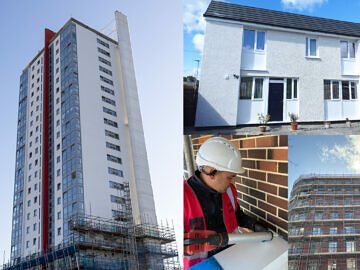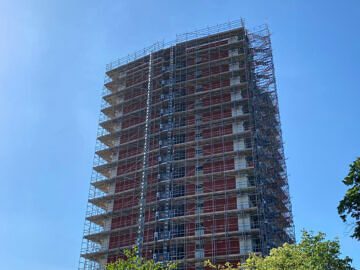If you’re living in a high-rise building in the UK, you’ve likely heard about the ongoing cladding crisis. The issue has escalated to such a degree that it’s now a pressing concern for thousands of property owners, tenants and builders alike. At Hamilton, we want to keep you informed and prepared.
Here’s a comprehensive overview of the cladding crisis, its origins, and what steps you need to take to address it.
The Origins of the Cladding Crisis
The cladding crisis gained national attention following the tragic fire at Grenfell Tower in 2017. This disaster claimed 72 lives and highlighted severe fire safety deficiencies in high-rise buildings. The exterior cladding of Grenfell Tower, which was highly combustible, allowed the fire to spread rapidly, trapping residents and hindering rescue efforts. This tragedy led to a nationwide reevaluation of fire safety regulations, particularly concerning the cladding used on high-rise buildings.
What is Advice Note 14?
In the wake of Grenfell, the UK government introduced Advice Note 14 as part of an effort to address fire safety concerns. This advisory document urged property owners to scrutinise their buildings’ cladding systems to ensure they meet fire safety standards. Consequently, property valuers and lenders began to treat flats with combustible cladding as potentially unsafe, which led to a need for formal certification before properties could be bought or sold.
The EWS1 Form: What It Is and Why It Matters
To manage cladding safety effectively, the External Wall Systems (EWS1) form was introduced. This form is essential for anyone living in a high-rise building with external cladding. Here’s how it works:
- Assessment: A qualified building safety inspector evaluates the cladding used on your building. If the cladding is found to be combustible, your building will not pass the EWS1 assessment.
- Remediation: If your cladding is deemed unsafe, you’ll need to work with a cladding removal company to replace it with a non-combustible alternative. Only then will you be able to achieve EWS1 compliance.
Who Needs EWS1 Compliance?
The EWS1 assessment applies to buildings with High Pressure Laminate (HPL) cladding that are five storeys or higher and feature linked balconies. As of January 2021, it’s advised that buildings below 18 metres do not need to request EWS1 forms. If your building meets these criteria, it’s crucial to get your cladding assessed.
Financial Aid for Cladding Remediation
The cost of cladding remediation can be substantial. Fortunately, there are financial aids available. The UK government has allocated significant funds to the Building Safety Fund to assist with the removal of non-ACM cladding systems in England. For those in Scotland, Wales, or Northern Ireland, local councils have their own guidelines and funding options. Check with your local authority to understand the support available to you.
What Should You Do Next?
Assess Your Cladding: If you’re unsure about the safety of your building’s cladding, arrange for a professional assessment as soon as possible.
- Seek Financial Assistance: Explore funding options to help cover the costs of cladding removal and compliance.
- Stay Informed: Keep up with the latest regulations and advice to ensure your building meets all safety standards.
At Hamilton, we are here to support you during the cladding remediation process. Our experienced team can assist with removal and replacement of unsafe cladding systems. Contact us today for more information.



